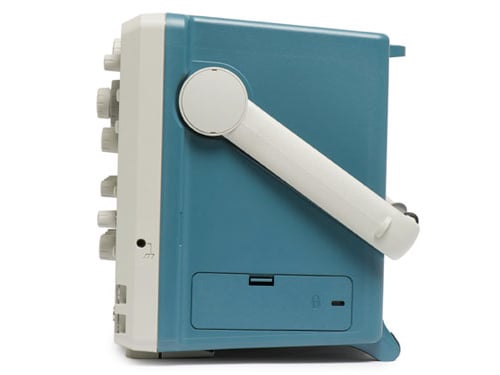

Tektronix recently added solid state hard drive option to several of its higher performance oscilloscopes known as Option SSD. Why would you want a solid state hard drive, and what value would it add to your lab?
Anyone who has purchased a performance oscilloscope that runs Windows, whether a Tektronix DPO5000 series that is easily portable or a high end DPO70000 series with bandwidths up to 33GHz, might have noticed that the hard drive is easily removable. You typically need to remove just two thumbscrews to get the hard drive out of a modern oscilloscope. On a DPO70000, the drive bay is located on the back of the oscilloscope, and on the DPO5000, it is located on the right hand side as shown below.

The DPO5000 oscilloscope gives easy access to the hard drive bay.
This feature was added because many users wanted an easy way to remove sensitive information from their machines, either when sending the instrument out for calibration or to meet mil/gov security requirements. Some users buy multiple drives with their instruments so they can share an instrument, but not share sensitive data and setups. Since calibration data and serial numbers are not stored on the hard drive, changing drives to change labs does not impact oscilloscope performance. In addition, removable hard drives allow easy replacement of a failed hard drive without breaking any calibration seals on the instrument.
SSD prices drop
The cost of solid state flash-based hard drives has dropped by over 50 percent over the past year, as shown in the chart below. Unlike traditional spindle drives, solid state drives are based on flash memory, similar to the removable storage on a digital camera. As a result of the price drop, many computer manufacturers are offering SSDs as an option on laptop PC’s. In a mobile world, SSDs are appealing because of their reduced power consumption, immunity to shock and performance. Not surprisingly, many of the same advantages carry over to the world of test and measurement.

Image Credit: The Tech Report
To start, many pieces of test equipment are used in high vibration environments. With its over-the-top handle, many DPO5000 series oscilloscopes are plugged into a long power cord and moved around a busy lab. In large industrial labs I have seen some creative (and scary) rigs used to hold oscilloscopes up on top of machinery. I once saw one with a long power cord actually mounted to a spinning table, trying to measure an anomaly that only happened during motion! Other instruments may be used inside vehicles or vans for mobile testing. Repeated vibration and motion can lead to early failure for a normal spindle-drive, but a flash drive is immune to these problems.
Faster boot up, processing
The other main advantage of a flash drive is speed. Since there is no head that must move and wait for rotating platters, the SSDs improve the speed of saving, recalling, and processing data. I recently upgraded my demo unit MSO72004C with a SSD to see how it performed. I was amazed by the results. Oscilloscope boot-up took 55 percent less time, a greater than 2x performance increase than the spindle drive. Normal waveform update rate was not affected as Tektronix uses special ASICs for the display, but the time to save to a file to disk and recall a file were both cut in half.
I also tested high-speed serial, most notably rendering an eye diagram from a large dataset using DPOJET. This is a particularly time-intensive task because the Tektronix DPOJET software creates a software PLL to recover the clock from the serial data. I found that eye diagrams rendered in half the time as well. Continuing into the RF realm, I tested SignalVu, an RF tool that not only downconverts RF to baseband I and Q, but can demodulate signals into symbol tables and constellation diagrams. Running SignalVu on a large dataset, I found the speed increase was similar to DPOJET, running about twice as fast as with the spindle drive.
If you are looking to get more done in less time, solid state drives are now offered as options on almost all oscilloscope models. And, since the drives are so easy to remove, it is quite possible that you can order an upgrade kit for your existing oscilloscopes, depending on the age of the instruments, to greatly improve your processing speed.


